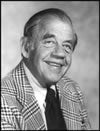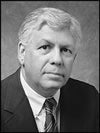The Western Reserve College was established in 1826, and the medical school was founded in 1843.
In 1967, Western Reserve University joined with Case Institute of Technology to form Case Western Reserve University. The School of Medicine at Case Western Reserve University is among the top institutions nationwide in federal research funding.
Although Harvey Cushing, MD, widely recognized as the founder of modern neurosurgery, was born in Cleveland, he never practiced in Ohio. However, he and his family played key roles in Cleveland's burgeoning status as a place of landmark medical discovery.
Three generations of his family practiced medicine in the area and were instrumental in the development of Western Reserve College as well as University Hospitals. In fact, Dr. Cushing is buried with his family in Lakeview Cemetery, which overlooks University Hospitals.
Neurological Surgery was first practiced at University Hospitals by George Crile, MD, and Elliott Cutler, MD, the latter a former Cushing protege. Claude S. Beck, MD, who trained under Dr. Cushing at Peter Bent Brigham Hospital as an Arthur Tracy Cabot research fellow in 1923, was named the first Professor of Neurological Surgery at Western Reserve University and Lakeside hospital in 1940. Dr. Beck practiced a combination of clinical neurosurgery and cardiac research until 1953. A formal professional chair in neurological surgery was endowed by the family of a prominent Cleveland businessman.
The present training program was started by Frank E. Nulsen, MD, in 1953. Dr. Nulsen left the University of Pennsylvania, where he had been instrumental in developing pressure-regulated one-way valves for the treatment of hydrocephalus, to head the new Division of Neurosurgery. Dr. Nulsen continued to pursue his interest in the treatment of hydrocephalus at University Hospitals, establishing a large and active program for treatment of children with hydrocephalus and myelodysplasia. He was best known for his dedication to the training and education of young neurosurgeons.
Keeping with a strong tradition of former residents and junior faculty continuing in academic medicine to become chairmen of their own programs, Dr. Nulsen held his post as Chairman of Neurological Surgery until his retirement in 1981 and was followed by Dr. Robert A. Ratcheson.
Under Dr. Ratcheson's leadership, the Department of Neurological Surgery thrived, positioning itself as one of the nation's premier neurosurgery programs. In 1991, it was established as a department at Case Western Reserve University's School of Medicine as well as Cleveland's University Hospitals Health System. The scope of the department was expanded to include now well-established programs in cerebrovascular neurosurgery such as endovascular techniques, neuro-endoscopy and stereotactic surgical techniques. Scholarly activity also increased during Dr. Ratcheson's tenure.
Dr. Ratcheson retired in July 2005 and was succeeded by Dr. Warren R. Selman.
Dr. Selman has been a member of the faculty since completion of his residency in 1984. In his tenure as chairman, Dr. Selman has been instrumental in the establishment of the University Hospitals Neurological Institute of which he has been named Director. The UH Neurological Institute -- the first comprehensive neuroscience center in Ohio -- brings together experts from multiple medical disciplines to treat a variety of routine and complex disorders of the nervous system more effectively. The Institute is now ranked by US News and World Report as one of the best neurosurgery programs in the nation.





